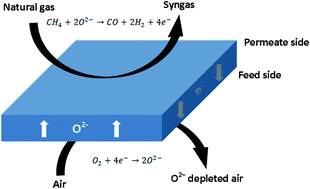Oxygen diffusion behaviour of A-site deficient (La0.8Sr0.2)0.95Cr0.5Fe0.5O3−δ perovskites in humid conditions†
Abstract
In the development of high temperature electrochemical devices such as oxygen transport membranes (OTMs) and solid oxide fuel cells (SOFCs), solid-state (ceramic) technologies have proven to be particularly promising. For example, doped lanthanum chromite perovskites, which display high thermo-chemical stability in aggressive environments as mixed ionic and electronic conducting (MIEC) perovskite electrodes, show potential for use as OTMs. Previous studies on the range of these MIEC perovskites have focussed on material behaviour under pure oxygen conditions. Recently, however, it has been suggested that components of air such as humid vapour may modify the materials' chemistry under device operating conditions, affecting device performance and durability. We have designed and carried out fundamental research into the effect of humidity on the oxygen surface exchange and diffusion kinetics of a commercialized (La0.8Sr0.2)0.95Cr0.5Fe0.5O3−δ (LSCrF8255) perovskite material under elevated OTM and SOFC operating conditions. The water surface exchange and oxygen ion diffusion behaviour of LSCrF8255 perovskites were measured through Isotopic Exchange Depth Profiling-Secondary Ion Mass Spectrometry (IEDP-SIMS) in a designed humid condition with an oxygen partial pressure of 200 mbar and a constant water vapour pressure of 30 mbar, from intermediate to high temperatures (600 °C to 900 °C). Our study demonstrates consistency between oxygen ion bulk diffusion kinetics in wet (pO2 = 200 mbar, pH2O = 30 mbar) and dry (pO2 = 200 mbar, pH2O = 0 mbar) oxygen atmospheres. However, limited surface exchange between water and the LSCrF material was observed above 800 °C. To study the limited water surface exchange behaviour, angle-resolved X-ray photoelectron spectroscopy (ARXPS), scanning electron microscopy (SEM), and scanning transmission electron microscopy (STEM) have been applied to correlate the changes in water surface exchange with chemical or topographic changes in the materials, such as Sr surface segregation processes. It was found that Sr segregation is one of the factors suppressing water surface exchange, although not the primary limiting factor. Another limiting factor was found through in situ residual gas analysis (RGA), which showed the dominance of homo-exchange between the humid vapour and gaseous oxygen molecules at high temperatures.



 Please wait while we load your content...
Please wait while we load your content...